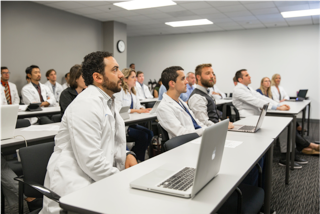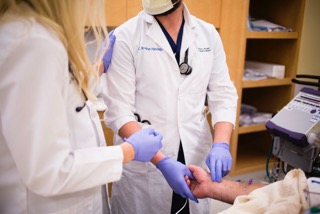Team Based Learning (TBL)
Laceration Repair for Emergency Physicians
DOI: https://doi.org/10.21980/J8TP7KBy the end of this educational session, the learner will: 1) understand indications and contraindications for suture repair of lacerations, 2) compare when various types of wound repair are appropriate: such as sutures, staples, tissue adhesive and tissue tape, as well as what size of suture material is appropriate depending on the location of the laceration on the body, 3) list the appropriate types and sizes of suture for various locations and types of lacerations, 4) understand the definitions of the three types of wound closure (primary, secondary and delayed primary) and when they are appropriate, 5) understand the basics of local anesthetic including which anesthetic to use and the maximum dose for each, 6) understand when sutures should be removed, 7) list various suturing techniques and their indications, and 8) improve comfort levels in performing various suturing techniques including: simple interrupted, horizontal mattress, vertical mattress, and corner repair. If desired, instructors can individually assess the learner sutures using the attached complete validated suture checklist to show proficiency in these techniques. Please see the brief wrap-up section at the end of the manuscript.
Left Ventricular Assist Devices
DOI: https://doi.org/10.21980/J8JP4ZUpon completion of this cTBL module, the learner will be able to: 1) Properly assess LVAD patients’ circulatory status; 2) appropriately resuscitate LVAD patients; 3) identify common LVAD complications; 4) evaluate and appropriately manage patients with LVAD malfunctions.
Emergency Medicine Dermatology
DOI: https://doi.org/10.21980/J8DW21By the end of this educational session, the learner will: 1) List the six primary types of rash (maculopapular, petechial/purpura, diffuse erythematous, non-erythematous, vesiculo-bullous, and pustular). 2) Be able to accurately describe various types of lesions and rashes with appropriate terminology; 3) Understand the use of the Modified Lynch Algorithm and how it can be used to narrow down the differential diagnosis in patients presenting with rash.
Ventilator TBL
DOI: https://doi.org/10.21980/J8H01MAt completion of this TBL the learner should be able to: 1. Choose appropriate ventilator settings and adjustments for a patient with lung injury or obstructive lung pattern 2. Troubleshoot an alarming ventilator 3. Set up the most common ventilator in their ED 4. Set up the equipment needed for transtracheal jet ventilation.
The Acute Red Eye
DOI: https://doi.org/10.21980/J8BC74By the end of this educational session, the learner will: 1) list 10 major causes for an acute red eye; 2) describe historical features that help distinguish between benign and serious causes of the acute red eye; 3) describe physical examination features that help distinguish between benign and serious causes of the acute red eye; and 4) use historical and physical examination features to distinguish between the 10 different causes of the acute red eye.
Transfusion Related Emergencies
DOI: https://doi.org/10.21980/J86P4VAt the end of this didactic session, the learner will be able to: 1) list the various transfusion reactions and their approximate incidence; 2) understand the pathophysiology behind each transfusion reaction; 3) describe the management for each type of transfusion reaction; and 4) discuss the plan for prevention of future transfusion reactions.
Emergencies in Hemophiliacs
DOI: https://doi.org/10.21980/J8301WBy the end of this session learners will be able to: 1) describe the underlying deficiencies of hemophilia A and B; 2) discuss the complications of hemophilia; 3) formulate an appropriate treatment plan for an acutely bleeding hemophiliac; 4) calculate the appropriate factor dosing for a hemophiliac with acute bleeding.
A Faculty Development Session or Resident as Teacher Session for Didactic and Clinical Teaching Techniques; Part 1 of 2: Engaging Learners with Effective Didactic Teaching
DOI: https://doi.org/10.21980/J8RP4TBy the end of this workshop, the learner will: 1) describe eight teaching techniques that encourage active learning during didactic sessions; 2) plan a didactic session using at least one of eight new teaching techniques for didactic instruction
A Faculty Development Session or Resident as Teacher Session for Clinical and Clinical Teaching Techniques; Part 2 of 2: Engaging Learners with Effective Clinical Teaching
DOI: https://doi.org/10.21980/J8MW2WBy the end of this workshop, the learner will: 1) describe and implement nine new clinical teaching techniques; 2) implement clinical teaching techniques specific to junior and senior resident learners.
Emergencies in Hemodialysis Patients
DOI: https://doi.org/10.21980/J81591By the end of this session, the learner will: 1) describe primary dialysis complications; 2) construct a full differential for a dialysis patient presenting with complications; 3) formulate an appropriate treatment and resuscitation in an acutely ill dialysis patient; 4) plan appropriate disposition and utilization of consultants for dialysis complications.
‹2
Page 2 of 2


